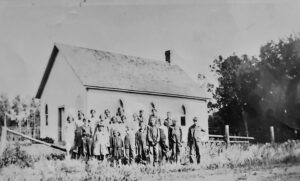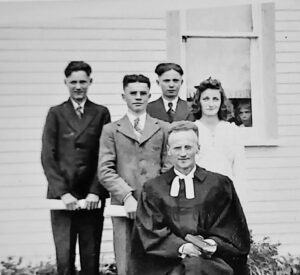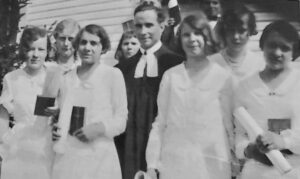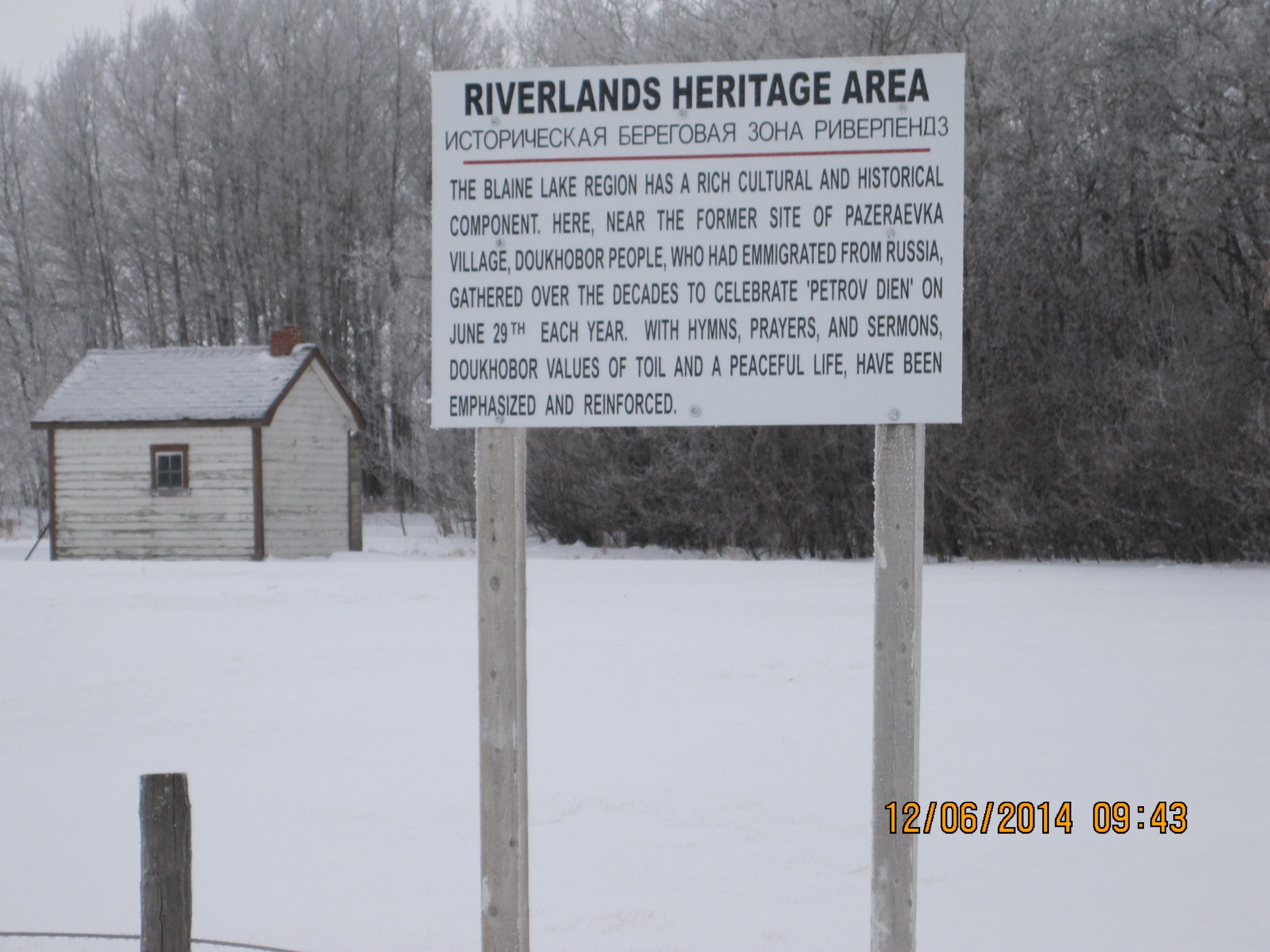The history of St. Paul’s Lutheran Church begins long before the building itself. In the late 1890s and early 1900s, Lutheran settlers—many of Russian and German origin—began to establish homesteads throughout the Silver Grove district. In those early years, before a formal place of worship existed, services were held in private homes. As more families arrived and the community grew, worship moved to the Silver Grove School, providing a more centralized location for gathering.

Photo of original construction of St. Paul’s Lutheran Church prior to the addition of the porch and steeple. Year unknown.
Recognizing the need for a dedicated place of worship, the congregation came together in 1917 to build St. Paul’s Lutheran Church. The land was generously donated by Adam Reidt, and both materials and labour were provided by the church’s own members—a testament to the strength and commitment of the community. Services were conducted in German, the language of many of the settlers, and the church quickly became a focal point for spiritual life across a large rural area where, at the time, families lived on nearly every quarter section.

Photo of original construction of St. Paul’s Lutheran Church prior to the addition of the porch and steeple. Year unknown.
St. Paul’s became much more than a place of worship. It was a centre for learning, celebration, and community life. The church hosted Saturday School and Christmas programs—complete with towering Christmas trees—as well as baptisms, confirmations, weddings, funerals, and committals. Some of the earliest recorded milestones include the baptism of John Hugo Reidt in 1900 and confirmations dating as far back as 1902. Family names found in the church’s early registers reflect the cultural fabric of the district: Reidt, Riffer, Thiel, Bischler, Urbinsky, Ehrstein, Dehring, Schultz, Seiter, Dortman, Schlichemeyer, Saam, Hoffman, Edel, Bittner, Stieb, Hohn, Kron, Krause, Beck, Mueller, Sommerfeldt, Lenz, Rabel, Ruchotzke, Steinbart, Gutsch, Hek, Bergen, and Gampe.

Confirmation in 1943, with Reverend Sterzer seated, Arnold Sommerfeld, Milton Reidt, Willie Bischler and Walle Gutsch.

Photo of confirmation in 1932. Back: Eveline Schultz, Rose Urbinsky, Gotfried Ehrstein, John Bischler, Hertha Schultz
Front: Doris Thiel, Bena Bischler, Rev. Edwin Risch, Martha Schlichemeyer, Elizabeth Bischler
Pastors who served St. Paul’s over the decades included Rev. Hugo Lanz, Magnus, Weidenhammer, Freitag, Risch, Klingbeil, Schwabe, Penner, Adelsberger, Intscher, Sterzer, and Erickson—each leaving a mark on the spiritual life of the community.
As the decades passed, life in the countryside began to change. Families grew and moved away, farms became larger and fewer, and rural populations began shifting toward towns and cities. By the late 1950s, regular weekly services at St. Paul’s began to decline, particularly in the winter months. Church services started being held in Leask with increasing frequency and eventually became the norm. By the mid-1960s, worship at St. Paul’s had been reduced to an annual summer service and picnic—an occasion that continues to bring together descendants, neighbours, and friends.
In recognition of its historical and cultural significance, the Province of Saskatchewan officially designated St. Paul’s Lutheran Church a Municipal Heritage Site in 1984. This designation, along with ongoing support from former congregants, their families, and heritage grants, has helped ensure the preservation of the church building and grounds. Maintenance efforts have included significant repairs and upkeep, all carried out by volunteers committed to honouring the legacy of those who came before.
Today, more than a century since it was built, St. Paul’s Lutheran Church remains a beloved symbol of faith, community, and resilience. Though regular services have long ceased, the church continues to serve as a meaningful location for baptisms, weddings, funerals, and family reunions. It stands as a quiet witness to the lives and stories of those who made the Silver Grove district their home—and a place where new generations can connect with that enduring heritage.
The town was settled in the late 1800s and grew rapidly with the Doukhobors’ arrival in 1899. It was, and is, a farming and business hub with many amenities and services.
Here, near the site of Pazeraevka village, Doukhobors who had come from Russia, and their descendants, gathered over the decades to celebrate ‘Petrov Dien’ or Peter’s Day on June 29th each year.
This cemetery, established at the turn of the last century by the Congregational Church of Canada, is the resting place of William Diehl (1850 – 1936). Diehl was one of three scouts during the Northwest Resistance of 1884-85 to whom Louis Riel surrendered.
Soil types in the area east of the towns of Blaine Lake, Marcelin, and Leask are varied – predominantly black soil (chernozems) as well as sandy loams and other types. In this mixed farming area, the variety of crops grown included cereals, legumes and oilseeds.
The school district (#2386) was formed in 1909, after much petitioning to government, and the school itself opened in 1911, near the Doukhobor village of Ospennia. After closure due to damage by lightning, the school was rebuilt in a new location, at SE–2–44–6 W3. The school served as a focal point for the community for many years, before closing in 1957.
A plains cottonwood crossed with balsam poplar, the Big Tree stands nearly 21 meters high at the present time, as its top was sheared off by lightning. The tree has a girth of 5 meters and a span reaching 32 meters. Estimates place its age at over 160 years. This tree is one of the last remaining giant cottonwoods, as most have fallen to saw and axe. It stands near the site of the former Laird Ferry.
As the tour continues, one passes the location of cemeteries, old village sites, and other historical entities. This cemetery served the nearby village of Ospennia, one of 12 villages within the Prince Albert land reserve set aside for Doukhobor people.
Located on NE 17 – 44 – 5 W3, this cemetery serves the Slavanka district. The cemetery house has been decorated in a style that has been influenced by Doukhobor settlers who arrived from southern Russia. Visitors are encouraged to spend time contemplating the passing of history, pay respect to those buried at Slavanka cemetery, and sign the guest book.
Saskatchewan is surveyed on a grid system with individual quarter sections measuring ½ by ½ mile. The measurement of river lots at Riverhill is different, affording proximity to the river.
Established in 1910, classes began in February 1912 with 14 students in attendance. The original school was destroyed by fire in 1931. A new school built on Riverlot North 7 – 45 – 5 W3 functioned as an education facility and community centre.
This memorial honors the people of the region who developed the land. Based on a sun dial design from the Renaissance Period, the armillary takes into account the latitude of the area, 53° N of the equator. A gnomon (arrow) points to Polaris (North Star) which remains nearly constant over the North Pole. The gnomon’s shadow is cast upon the numbers of the horizon ring, indicating real time. Riverhill Cemetery continues to function as a focal point of the district. Visitors are welcome to stop by and sign the guest book.
A typical aspen-parkland slough has a wet meadow perimeter transitioning to deeper open water in the middle. Each zone provides distinct habitat for flora and fauna. At this location, 15 or more species of waterfowl may be sighted at various times of the year. Associated with sloughs and marshes are many species of ducks, geese, shorebirds and songbirds.
Dating to prehistory, the trail began as an aboriginal trail following the great buffalo herds. In the late 1700s, it developed as an overland route for explorers, fur traders and settlers and was the main trail between Fort Gary of the Red River District in Manitoba and Fort Edmonton. The trail came into prominence in the mid-1800s but declined with the advent of steamboats and the railway. Known locally as Snake Plain Trail, it winds its way northwest towards Green Lake. Today, a pleasant drive through the historic parklands countryside may be taken from Carlton Crossing to the Town of Leask.
Founded by Dr. Benjamin Ralph in 1904, Craigmore was named after a college in Ireland. Dr. Ralph arrived in the district to homestead and to provide leadership, serving with distinction until his death in 1930. His grave is in the Craigmore Cemetery. Considered by many to be among the most peaceful and serene locations in Saskatchewan, this idyllic little country church is a favorite spot to visit.
High on the banks of the North Saskatchewan River, one stands on soil crossed by prehistoric buffalo hunters, fur traders on Red River carts, and later homesteaders who developed the land. From this vantage point, one can imagine a scene of canoe brigades, York boats and later, steam boats. Across the river is Fort Carlton, formerly a bustling trade centre and transportation hub in the 1800s and now a provincial park.
Named after an area in southwest England, Chellwood School was established in 1909 at a meeting of four people. Located on NE 28-45- 4-W3, the school and teacherage were built the following year, with 20 students in attendance. It operated until 1961.
Within this habitat area of the riverlands region, over 50 species of mammals may be sited. Larger mammals include wolf, fox, coyote, lynx, cougar, bear, deer, moose and elk. Many smaller animals abound, with over 25 species of mice, gophers, voles and squirrels. Over 200 species of birds may be sited at various times of the year.
From this vantage point, one sees an example of transition from the aspen-parklands to the southern boreal forest. The resulting habitat is rich in flora and fauna with over 50 species of mammals, about 230 species of birds, and other creatures. A wide variety of trees, shrubs and other plants may be found in the area.
This section of the Fort Carlton Trail passes through the light sandy loam soils of the transition zone between the aspen parklands and the southern boreal forest. In addition to the predominant white spruce and trembling aspen, there are many shrubs, including: saskatoon berry, chokecherry, pincherry, red-ozier dogwood, wolf willow, hazelnut, and hawthorn.
Fort Carlton was the main provisioning centre along the Fort Carlton Trail linking Fort Gary in Manitoba with Fort Edmonton and points north. Carlton Trail had many branches. This section of the trail, which wound its way northwest to Green Lake, was a major route for hauling trade goods to northern posts and returning with furs. Its more recent history relates to settlement.
Established in 1910, the original Ottawa School was destroyed by fire. The new school, rebuilt in 1930, functioned until closing in 1958. As with many country schools, it was a focus of the community providing not only education facilities but a centre for meetings, socials, dances, Christmas concerts, and sports days. The school, with a nearby orchard, is privately owned and has undergone some restoration.
Originating as Anabaptists during the reformation of the 1500s, Hutterite people were persecuted and forced to relocate frequently throughout many areas of Europe. Eventually settling in Russia, an opportunity arose to go to North America. Hutterites live within a structure society with communal sharing of property, goods, and services. Hutterites are known for their hard work in agriculture and a focus on self-sufficiency.
Saskatchewan’s aspen parklands are dotted with potholes, sloughs and marshes, providing habitat for many species of ducks, geese, shorebirds, and songbirds. This marsh area extends many kilometers to the North and to the South. At least 200 species of birds may be sighted in the general area – breeding, migrating or wintering.
In 1944, the Sisters of Our Lady of the Cross came to Marcelin area to help build and run a home for the aged, supported by a generous local donation. St. Joseph Home received its first resident in August 1944. It included an agricultural operation to sustain the facility and its residents. A large barn, now privately owned and visible from the cemetery, marks the location of the home. This cemetery, part of the home’s operation, is no longer active. In 1956, the Sisters moved to Prince Albert to establish Mont St. Joseph Home there.
This site was the original location of a settlement founded by Antoine Marcelin in 1902. With the coming of the railroad, which bypassed this site, the village moved to its current location, a half-mile west across Highway 40.
The town sits at the corner of Highway 40 and Grid Road 783. In about 1913, the town was moved from its original location, a half-mile east, to be closer to the new CN rail line. It is home to St. Joseph’s Roman Catholic Church, the largest church in the region, and is a business/ service centre for the local area. It also houses administrative offices for nearby Muskeg Lake First Nation. The town’s cemetery makes an interesting stop, as it reflects the cultural diversity of the area.
The first St. Joseph Roman Catholic Church was a wooden structure built in 1904 at the original Marcelin town site. When the village was moved to its present location, a new church was built to house the growing congregation. Its architect, Theodore de Byl, was noted for building churches for French Canadian Roman Catholic communities in Western Canada using local brick and fieldstone. Completed in 1923, it was renamed St. Joseph’s Parish, Marcelin. It is now a Municipal Heritage Property. The parish included a convent for some time; its nuns were known for teaching school and music to local children.
This cemetery serves much of the local Ukrainian Catholic community and is associated with the Our Lady of Perpetual Help Ukrainian Catholic Church in Blaine Lake. It has about 80 graves and is beautifully maintained.
Petrofka was a major first settlement of Russian Doukhobors who came to Canada in 1899 and settled throughout Western Canada. Near here, they wintered in homes dug into the river bank. Petrofka Village site was well-chosen, near a spring (now Petrofka Spring) and a good river crossing (now Petrofka Bridge). Near the village, there was a flour mill on Radouga Creek , a cemetery and a school (Petrofka School District No. 23). RHPRI acknowledges the support of the Saskatchewan Ministry of Parks, Culture and Sport in permitting us to place information signs and picnic tables at the Petrofka Spring Site.
This cemetery sits on NE 25–42–7 W3, slightly southwest of the bridge, and was established in 1899 near Petrofka Village. Although the village disbanded in 1929, the cemetery continues to serve the surrounding community. It has approximately 100 graves, many being very old and unmarked. It features tall pines in the centre, a common feature of rural cemeteries to make their location visible from a distance in many types of weather.






























